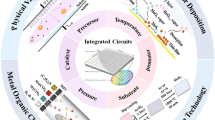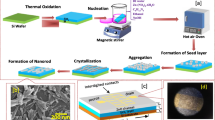Abstract
Silicon nanowires (SiNWs) were obtained on p-Si (100) substrate by Ag-assisted chemical etching method in two-step process. The influence of the etching duration on the morphological, optical and electrical properties of SiNWs samples was investigated. SEM images show clearly the presence of nanowires and the existence of porous silicon structure especially for low etching duration. Fourier Transformed Infrared spectroscopy (FTIR) measurements allow identifying several particles on the SiNWs surfaces such as oxygen and hydrogen elements. The optical properties of the SiNWs layer were investigated by Photoluminescence spectroscopy (PL). A strong broad PL band was observed at room temperature for an etching time of 30 s. The PL spectra exhibit multi-band profile in the red-green region. The luminescence of SiNWs is mainly attributed to Si-oxide interface states and oxygen deficient centers. Ag/SiNWs/Si Schottky diodes were analyzed by X-ray diffraction (XRD) and studied by current - voltage (I-V) measurements. Diode parameters such as ideality factor (n), series resistance (Rs), saturation current (Is) and energy barrier (φb) were determined by analyzing the I-V characteristics. Ag/SiNWs/Si diode for an etching duration of 30 s exhibits a rectifying behavior with a factor ideality of 2.8 and a low threshold voltage of about 0.44 V in forward bias. Space charge limited current (SCLC) model is the dominant transport mechanism through Ag/SiNWs/Si diode. The trap states, on the Ag/SiNWs interface, play in important role in the conduction phenomenon through these structures.
Similar content being viewed by others
References
Jia G, Höger I, Gawlik A, Dellith J, Bailey LR, Ulyashin A, Falk F (2013) Wet chemically prepared silicon nanowire arrays on low-cost substrates for photovoltaic applications. Phys Status Solidi A 210(4):728–731
Amdouni S, Coffinier Y, Szunerits S, Zaïbi MA, Oueslati M, Boukherroub R (2016) Catalytic activity of silicon nanowires decorated with silver and copper nanoparticles. Semicond Sci Technol 31:014011–014018
Cui Y, Zhong Z, Wang D, Wang WU, Lieber CM (2003) High performance silicon nanowire field effect transistors. Nano Lett 3(2):149–152
Bessire CC, Björk MT, Schenk A, Riel H (2012) Silicon nanowire Esaki diodes. Nano Lett 12:699–703
Zhu LS, Zhang J, Xu XW, Yu YZ, Wu X, Yang T, Wang XH (2016) Room temperature H2 detection based on Pd/SiNWs/p-Si Schottky diode structure. Sensors Actuators B 227:515–523
Wagner RS, Ellis WC (1964) Vapor-liquid-solid mechanism of single crystal growth. Appl Phys Lett 4:89–90
Schmidt V, Wittemann JV, Senz S, Gösele U (2009) Silicon nanowires: a review on aspects of their growth and their electrical properties. Adv Mater 21:2681–2702
Huang Z, Geyer N, Werner P, de Boor J, Gösele U (2011) Metal-assisted chemical etching of silicon. Adv Mater 23:285–308
Peng KQ, Lu AJ, Zhang RQ, Lee ST (2008) Motility of metal nanoparticles in silicon and induced anisotropic silicon etching. Adv Funct Mater 18:3026–3035
Chartier C, Bastide S, Lévy-Clément C (2008) Metal-assisted chemical etching of silicon in HF–H2O2. Electrochim Acta 53:5509–5516
Tian JL, Zhang HY (2015) Controllable growth of silicon nanowire arrays fabricated by two-step silver catalyzed chemical etching. Superlattice Microst 88:180–187
Li Z, Wang X, Liu S, Yang J, Shi K, Wang H, Zhu D, Xing X (2018) Broadband photoluminescence of silicon nanowires excited by near-infrared continuous wave lasers. Opt Laser Technol 99:81–85
Gonchar KA, Osminkina LA, Galkin RA, Gongalsky MB, Marshov VS, Timoshenko VY, Kulmas MN, Solovyev VV, Kudryavtsev AA, Sivakov VA (2012) Growth, structure and optical properties of silicon nanowires formed by metal-assisted chemical etching. J Nanoelectron Optoelectron 7:602–606
Naama S, Hadjersi T, Keffous A, Nezzal G (2015) CO2 gas sensor based on silicon nanowires modified with metal nanoparticles. Mater Sci Semicond Process 38:367–372
Baba Ahmed L, Naama S, Keffous A, Hassein-Bey A, Hadjersi T (2015) H2 sensing properties of modified silicon nanowires. Prog Nat Sci Mater Int 25:101–110
Wang Z, Zhu M, Chen X, Yan Q, Zhang J (2013) Defect-assisted tunneling current-transport mechanism for Schottky diodes of Pt thin film on p-SiNWs tips. Microelectron Eng 103:36–41
Nassiopoulou AG, Gianneta V, Katsogridakis C (2011) Si nanowires by a single-step metal-assisted chemical etching process on lithographically defined areas: formation kinetics. Nanoscale Res Lett 6:597–598
Amri C, Ouertani R, Hamdi A, Ezzaouia H (2016) Effect of acid vapor etching on morphological and opto-electric properties of flat silicon and silicon nanowire arrays: a comparative study. Superlattice Microst 91:278–289
Chouaibi B, Radaoui M, Nafie N, Ben Fredj A, Romdhane S, Bouchriha H (2017) Study of magnetoconductance effect in silicon nanowires formed by chemical etching in HF/AgNO3 solution: Effect of etching time. J Cryst Growth 463:54–58
Bisi O, Ossicini S, Pavesi L (2000) Porous silicon: a quantum sponge structure for silicon based optoelectronics. Surf Sci Rep 38:1–126
Gorbanyuk TI, Evtukh AA, Litovchenko VG, Solnsev VS, Pakhlov EM (2006) Porous silicon microstructure and composition characterization depending on the formation conditions. Thin Solid Films 495:134–138
Hajji M, Khalifa M, Ben Slama S, Ezzaouia H (2013) Homogeneous luminescent stain etched porous silicon elaborated by a new multi-step stain etching method. Appl Surf Sci 284:324–330
Balarin M, Gamulin O, Ivanda M, Kosović M, Ristić D, Ristić M, Musić S, Furić K, Krilov D, Brnjas-Kraljević J (2009) Structural, optical and electrical characterization of porous silicon prepared on thin silicon epitaxial layer. J Mol Struct 924-926:285–290
Lavalley JC (1996) Infrared spectrometric studies of the surface basicity of metal oxides and zeolites using adsorbed probe molecules. Catal Today 27:377–401
Prokes SM, Carlos WE, Glembocki OJ (1994) Defect-based model for room temperature visible photoluminescence in porous silicon. Phys Rev B50:17093–17096
Marin O, Gennaro AM, Tirado M, Koropecki RR, Comedi D (2015) White light from annealed porous silicon: broadband emission from violet to the near infrared. Mater Lett 150:55–58
Benyahia B, Guerbous L, Gabouze N, Mahmoudi B (2013) Photoluminescence time-resolved emission and photoresponse of plasma-modified porous silicon thin films. Thin Solid Films 540:155–161
Chong SK, Goh BT, Dee CF, Rahman SA (2013) Effect of substrate to filament distance on formation and photoluminescence properties of indium catalyzed silicon nanowires using hot wire chemical vapor deposition. Thin Solid Films 529:153–158
Kayahan E (2010) White light luminescence from annealed thin ZnO deposited porous silicon. J Lumin 130:1295–1299
Djurišić AB, Leung YH, Tam KH, Ding L, Ge WK, Chen HY, Gwo S (2006) Green, yellow and orange defect emission from ZnO nanostructures: Influence of excitation wavelength. Appl Phys Lett 88:103–107
Rahmani M, Moadhen A, Zaïbi MA, Elhouichet H, Oueslati M (2008) Photoluminescence enhancement and stabilisation of porous silicon passivated by iron. J Lumin 128:1763–1766
Ensafi AA, Rezaloo F, Rezaei B (2016) Electrochemical sensor based on porous silicon/silver nanocomposite for the determination of hydrogen peroxide. Sensors Actuators B Chem 231:239–244
Ortiz AL, Sanchez-Bajo F, Cumbrera FL, Guiberteau F (2001) X-ray powder diffraction analysis of a silicon carbide-based ceramic. Mater Lett 49:137–145
Ahmed N, Ramasamy P, Balaji Bhargav P, Rayerfrancis A, Chandra B (2020) Development of silicon nanowires with optimized characteristics and fabrication of radial junction solar cells with < 100 nm amorphous silicon absorber layer. Mater Sci Semicond Process 106(104778):1–6
Das M, Sarkar D (2016) Morphological and optical properties of n-type porous silicon: effect of etching current density. Bull Mater Sci 39:1671–1676
Ulfa DK, Ulfa M (2019) Kinetics performance for cadmium (II) ion adsorption using mesoporous silica embedded with Iron oxide. Orient J Chem 35:20–27
Kanungo PD, Zakharov N, Bauer J, Breitenstein O, Werner P, Goesele U (2008) Controlled in situ boron doping of short silicon nanowires grown by molecular beam epitaxy. Appl Phys Lett 92:263107–263103
Schmidt V, Senz S, Gösele U (2007) Influence of the Si/SiO2 interface on the charge carrier density of Si nanowires. Appl Phys A Mater Sci Process 86:187–191
Rahmani M, Moadhen A, Zaibi MA, Lusson A, Elhouichet H, Oueslati M (2009) Electrical performance in iron-passivated porous silicon film. J Alloys Compd 485:422–426
Altındal Ş, Yücedağ I, Tataroğlu A (2010) Analysis of surface states and series resistance in au/n-Si Schottky diodes with insulator layer using current–voltage and admittance–voltage characteristics. Vacuum 84:363–368
Acknowledgements
The authors would like to thank Pr. Radouane Chtourou and Pr. Wissem Dimassi (Laboratoire de Nanomatériaux et Systèmes des Energies Renouvelables - Centre de Recherche de Borj Cédria Hammam-Lif Tunis - Tunisia) for FTIR and XRD measurements. The authors gratefully acknowledge Pr. Rabeh Boukharroub (Univ. Valenciennes, Lille – France) for his help to perform SEM images.
Author information
Authors and Affiliations
Corresponding author
Additional information
Publisher’s Note
Springer Nature remains neutral with regard to jurisdictional claims in published maps and institutional affiliations.
Rights and permissions
About this article
Cite this article
Rahmani, M., Amdouni, S., Zaïbi, Ma. et al. Effect of Etching Duration on the Morphological and Opto-Electrical Properties of Silicon Nanowires Obtained by Ag-Assisted Chemical Etching. Silicon 13, 179–187 (2021). https://doi.org/10.1007/s12633-020-00416-2
Received:
Accepted:
Published:
Issue Date:
DOI: https://doi.org/10.1007/s12633-020-00416-2




